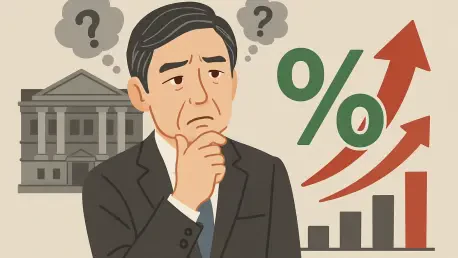In the heart of Osaka, a pivotal question looms over Japan’s economic landscape: can the Bank of Japan (BOJ) push forward with an interest rate hike amid a storm of global uncertainties? Picture a nation on the cusp of breaking free from decades of deflation, only to face headwinds from faltering economies abroad and looming trade barriers. BOJ Governor Kazuo Ueda’s recent remarks to business leaders have ignited a firestorm of speculation, as markets and policymakers alike grapple with the delicate balance between domestic recovery and international risks. This is not just a policy decision—it’s a high-stakes gamble for Japan’s future.
Unpacking the Stakes for Japan’s Economic Path
The significance of the BOJ’s next move cannot be overstated. An interest rate hike signals confidence in Japan’s recovery and a step toward normalizing monetary policy after years of ultra-low rates aimed at combating deflation. With inflation targets in sight, this decision could reshape everything from corporate investment strategies to household spending patterns, positioning Japan as a key player in global economic stability. Yet, the shadow of external threats, such as a weakening U.S. economy, complicates this trajectory, making the timing of any hike a critical point of debate.
Beyond domestic implications, the BOJ’s actions resonate on a global stage. Investors and analysts worldwide are watching closely, as Japan’s monetary policy could influence currency markets, particularly the yen’s value, and set a precedent for how central banks navigate uncertainty. The pressure is on for Governor Ueda to strike a balance, ensuring that a premature hike doesn’t stifle growth while a delayed move risks missing the inflation window. This is a defining moment for Japan’s economic narrative.
Why the Timing of a Rate Hike Is Critical
Delving deeper, the urgency of the BOJ’s decision hinges on its long-standing battle against deflation. A rate hike would mark a historic shift, affirming that inflation is sustainable and paving the way for wage growth—a cornerstone of economic vitality. However, recent data suggests that external factors, like a slowdown in U.S. labor markets, could dampen Japan’s export-driven sectors, potentially derailing these ambitions.
For Japanese businesses, the outcome will dictate financial planning. A hike could increase borrowing costs, squeezing margins for firms already navigating global supply chain disruptions. Households, too, stand to feel the impact, as higher rates might curb spending just as consumer confidence begins to rebuild. The BOJ’s challenge is clear: move too soon, and risk stunting recovery; wait too long, and inflation could slip out of reach.
The global lens adds another layer of complexity. With the U.S. as a major trading partner, any economic downturn there directly affects Japanese markets. Governor Ueda has flagged this as a primary concern, noting that a faltering U.S. economy could suppress demand for Japanese goods, undermining the very inflation the BOJ seeks to sustain. This interconnectedness underscores why timing is everything.
Global Threats Looming Over BOJ’s Strategy
Turning to specific risks, several international challenges are casting long shadows over the BOJ’s plans. A key worry is the deteriorating U.S. labor market, which Governor Ueda highlighted as a potential trigger for reduced demand for Japanese exports. If American consumers tighten their belts, Japan’s manufacturing and tech sectors could face significant setbacks, directly impacting economic growth.
Another pressing issue is the threat of higher U.S. tariffs, which could erode Japanese corporate profits. Ueda pointed out that such policies might force companies to prioritize cost-cutting over wage hikes, a move that would suppress inflation and weaken the case for a rate hike. This trade policy uncertainty adds a volatile dimension to the BOJ’s calculations, as firms brace for potential market access barriers.
Compounding these concerns are logistical hurdles, such as delays in critical U.S. economic data due to government shutdowns. Ueda acknowledged this as a serious obstacle but emphasized the BOJ’s readiness to pivot to alternative indicators to maintain decision-making clarity. This adaptability is crucial, yet it highlights the precarious nature of relying on incomplete global information in shaping national policy.
Market Sentiments and Expert Takes on Ueda’s Caution
Governor Ueda’s measured tone during his Osaka address has sparked a spectrum of reactions from markets and analysts. Shotaro Mori, a senior economist at SBI Shinsei Bank, noted that the lack of a definitive signal for an October hike suggests a more likely December timeline, reflecting a cautious approach to global headwinds. This interpretation aligns with market behavior, as the Japanese yen softened slightly post-speech, indicating investor skepticism about an immediate policy shift.
Financial markets are not the only ones parsing Ueda’s words. Policy experts see his upcoming attendance at the International Monetary Fund (IMF) meeting in Washington as a strategic move to gather broader economic insights. This step reinforces the notion that international perspectives will heavily influence the BOJ’s stance, lending weight to concerns about external risks over domestic momentum. The consensus seems to tilt toward patience, as stakeholders await clearer signals from global economic trends.
The ripple effects of this uncertainty are palpable. Currency traders, for instance, are adjusting positions based on the yen’s fluctuations, while Japanese firms hold off on major investments, wary of borrowing costs in a potential rate hike scenario. Ueda’s deliberate ambiguity, while frustrating for some, appears designed to keep options open as the global picture evolves, a tactic that may buy time but also fuels speculation.
Strategies for Navigating an Uncertain Monetary Future
Amid this fog of uncertainty, actionable measures can help the BOJ and stakeholders prepare for potential delays in rate adjustments. One approach is to lean on alternative economic indicators, especially with disruptions in U.S. data availability. By focusing on regional trade statistics and domestic consumer behavior, both the BOJ and businesses can build a more robust picture of economic health, reducing reliance on delayed international figures.
Another critical step is preparing for market volatility. Investors and corporations should develop contingency plans for both an October and December hike, factoring in currency shifts like the yen’s recent weakening. Hedging strategies and flexible financial models can mitigate risks, ensuring that sudden policy changes do not catch stakeholders off guard. This proactive stance is essential in a landscape where timing remains elusive.
Finally, engagement in global dialogues offers a pathway to clarity. Ueda’s emphasis on the IMF meeting signals the value of international cooperation in addressing risks like trade tariffs or economic slowdowns. Japanese policymakers and firms should actively participate in such forums, leveraging shared insights to anticipate challenges and craft informed responses. Building these networks could be the key to navigating the turbulent waters of global economics.
Reflecting on a Pivotal Moment
Looking back, the discourse surrounding the BOJ’s potential rate hike captured a nation at a crossroads, balancing domestic aspirations with global realities. Governor Ueda’s cautious rhetoric in Osaka underscored the weight of external risks, from U.S. economic woes to trade policy threats, which shaped market sentiments and expert analyses alike. The yen’s subtle decline and the shift in expectations toward a later hike reflected a collective holding of breath.
Moving forward, the focus shifted to adaptability—whether through alternative data sources or strategic international engagements like the IMF meeting. Stakeholders across Japan began to recalibrate, crafting plans to weather potential delays and volatility. The path ahead demanded vigilance, with an eye on both domestic indicators and global currents to ensure that when the moment for a rate hike arrived, Japan stood ready to seize it.









